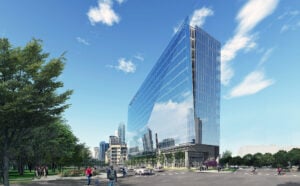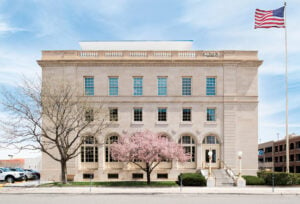Benefits and Emerging Trends in Sustainable Construction
We all understand the environmental impact of green building and LEED-certified construction; however, it isn’t often that our industry talks about the benefits of sustainable construction that go beyond just a healthier earth and living/working spaces. Sustainable construction and obtaining LEED certification helps owners and general contractors save money and build their reputation.
- The Beck Group's Director of Sustainability discusses the benefits of sustainable construction
- Preconstruction teams are essential to sustainable construction projects in making the right decisions early in the project
- Sustainable construction not only helps build a better environment but also increases a company's bottom line
- Recent trends in sustainable construction include carbon neutrality and social equity
Green building practices are becoming more in-demand and not just by the people who live and work in buildings, soon, building sustainably will be the norm. Autodesk writes that “construction output is projected to grow by a staggering 2.5 trillion square feet by 2060. (For perspective, that’s like building one New York City each month for the next four decades.)” And since the construction industry uses almost half of the world’s energy, it won’t be a surprise if green building and sustainable construction will soon be standard.
We sat down with Natalie Terrill, Director of Sustainability at DESTINI Estimator client, The Beck Group, and asked her about the benefits of sustainable construction and the trends she sees emerging.
 The Beck Group's RiverSouth building began with a LEED Silver goal and is finishing strong with a Gold certification. Copyright© The Beck Group
The Beck Group's RiverSouth building began with a LEED Silver goal and is finishing strong with a Gold certification. Copyright© The Beck Group
What is Preconstruction’s Most Important Role in Sustainability Projects?
In a paper titled “Effect of Preconstruction Planning on Costs and Sustainability” written by Cristiane Kreitler, her data shows that “97% of the respondents believed that preconstruction planning is an essential tool to achieve LEED Certification.”
Preconstruction teams play a critical role in sustainable construction. One of a preconstruction estimator’s abilities is to determine if the scope of the project is feasible within an owner’s expected budget. Without their knowledge and creative problem solving, like sourcing alternative materials and collaborating with designers and subs, a project could be lost due to not being able to maintain the integrity with the owner’s vision.
During the preconstruction process, especially with innovative precon technology like advanced estimating software, estimators can present a variety of choices for owners not only in sustainable building materials that save money but in many ways design can minimize environmental impact—making the project more financially sustainable in the long term.
Natalie says, “Precon is essential in sustainability because it allows us to make early decisions for what strategies to implement based on cost, return on investment, constructability, and what brings the best value to the project. As an integrated team, we are able to investigate options and present the most viable solution. This process builds confidence and trust with the client.”
What are the Main Benefits of Sustainable Building?
Natalie: Sustainable buildings operate more efficiently, save money, are more resilient to extreme weather, and provide a healthier place for people while being respectful to the environment and community.
Is Sustainable Construction Profitable/Good for the Bottom Line as well as the Environment?
Natalie: Yes. Every sustainable building should be taking an efficiency-first approach to reduce energy, water, and waste. Sustainable construction operations on job sites can lead to fewer health impacts on workers. A healthier working environment can increase productivity, reduce absenteeism and job-related incidents, and lower health insurance premiums. Reduced waste leads to fewer dumpster hauls and healthier building materials expose people to fewer harmful substances. The traditional premium we used to see for “green materials” can be avoided because these products are now readily available from most major manufacturers. An efficient construction process aims to create efficiencies and eliminate multiple forms of waste—that improves the bottom line and lessens the burden on natural resources.
How has Construction Sustainability Evolved Throughout Your Career? What Trends are Emerging?
Natalie: There is a new focus on carbon neutrality and social equity. In the past, the focus was solely on tracking recycled content, regional materials, sustainably sourced wood or renewable materials, and low-emitting products. Today we are focused on building material transparency that addresses a larger topic of human health and environmental impacts. This includes embodied carbon, which quantifies the greenhouse gas emissions associated with building construction and material extraction, transportation, manufacturing, installation, operational, and end-of-life.
What Drew You to Work in Sustainability? Is a Contractor Being LEED Accredited a Talent Draw?
Natalie: I’ve always believed that if we can do better then we must try to. Our industry is inherently bad for the environment, yet necessary. We must reduce these impacts in ways that benefit our clients and help people live happier healthier lives. From our perspective, it is always best to work with a knowledgeable team so a LEED Accredited professional coordinating the contractor’s efforts leads to a more successful project because they know and understand the goals and requirements to reach them.
What is one of Beck Group’s Most-Recognized Sustainable Projects?
 The Wayne N. Aspinall Courthouse achieved a LEED Platinum certification and net-zero energy in 2013. Image Courtesy of The Beck Group.
The Wayne N. Aspinall Courthouse achieved a LEED Platinum certification and net-zero energy in 2013. Image Courtesy of The Beck Group.
Natalie: The Wayne N. Aspinall Courthouse was a major renovation of a historic building that achieved a LEED Platinum certification and net-zero energy in 2013. The SMU Dallas Hall also comes to mind as another historic building that has achieved a LEED for Existing Buildings Gold certification in 2015 and was recertified in 2021. These are two great examples that any building can be sustainable. For recent new construction projects, we are proud of the RiverSouth building, which began with a LEED Silver goal and is finishing strong with a Gold certification due to the project team’s integrated process and the owner’s commitment to sustainability. The three TEC de Monterrey Mexico City Campus projects are an amazing success story of rebuilding a culturally appropriate campus using sustainable and resilient technologies after the 2017 earthquake damaged the majority of the campus. And lastly, our own Beck Headquarters tenant fit-out in Dallas is pursuing LEED Silver certification and a Fitwel 2-Star rating. This signifies that we walk our talk and have first-hand experience.

-1.png?width=112&height=112&name=image%20(4)-1.png)














